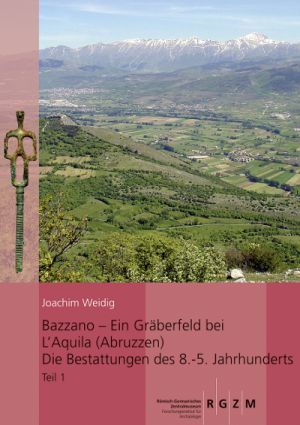
Zitationsvorschlag
Lizenz

Dieses Werk steht unter der Lizenz Creative Commons Namensnennung - Weitergabe unter gleichen Bedingungen 4.0 International.
Veröffentlicht
Downloads
Bazzano – ein Gräberfeld bei L’Aquila (Abruzzen)
Die Bestattungen des 8.-5. Jahrhunderts v. Chr.
Bazzano bei L'Aquila gehört zu den größten vorrömischen Bestattungsplätzen im apenninischen Mittelitalien und übertrifft in der Zahl der Gräber sogar die Nekropolen von Fossa und Campovalano.
Über 500 Bestattungen der orientalisierenden und archaischen Zeit (8.-5. Jahrhundert v. Chr.) aus den Grabungen der Soprintendenza per i Beni Archeologici dell'Abruzzo von 1992-2004 werden in dieser Publikation erstmals vorgelegt und ausgewertet.
Vor allem etruskische Keramikimporte und deren lokale Adaptionen ermöglichen innerhalb einer absoluten Chronologie eine feinere Datierung der Gräber mit ihren älter wirkenden traditionellen italischen Schmuckelementen und Waffen. Dadurch kann auch die anhand von Seriationen und Gräberüberschneidungen erstellte Belegungsabfolge der Nekropole in vier Hauptphasen besser mit den bestehenden Chronologiesystemen verglichen werden.
Neben Fragen zu Bestattungsbräuchen und Sozialstrukturen ist der Hauptteil der Arbeit der Klassifizierung und zeitlichen Einordnung von typischen mittelitalischen Objekten gewidmet, die weit über Bazzano hinaus verbreitet sind. Mit den ergänzenden anthropologischen Beiträgen wird das Bild einer mobilen eisenzeitlichen Bevölkerung entworfen, die sich in ihrer Lebensführung von den in der benachbarten Nekropole von Fossa bestattenden Individuen unterschied. Möglicherweise geht dies auf eine ausgeprägte Weidewirtschaft, auf Transhumanz oder aber auf eine sehr aktive Kriegerschicht zurück, deren Stellung auch durch die hohe Anzahl von waffenführenden Gräbern hervorgehoben wird.






